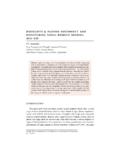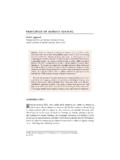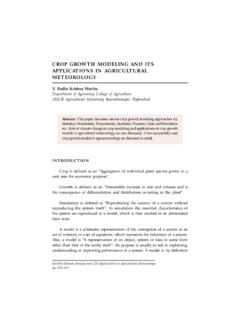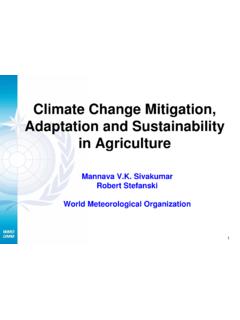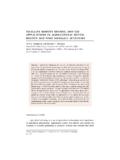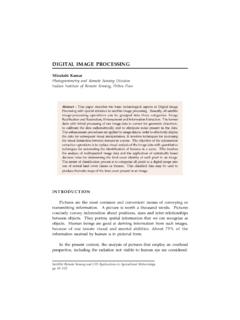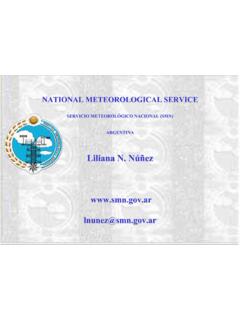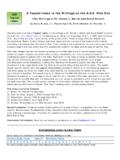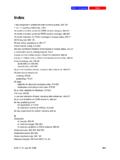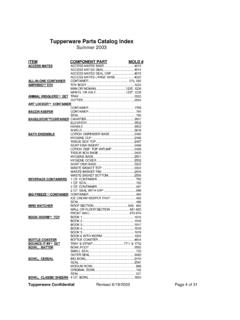Transcription of Standardized Precipitation Index User Guide
1 Standardized Precipitation Index user GuideWMO-No. 10902012 WMO-No. 1090 Standardized Precipitation Index user GuideWMO-No. 1090 World Meteorological Organization, 2012 The right of publication in print, electronic and any other form and in any language is reserved by WMO. Short extracts from WMO publications may be reproduced without authorization, provided that the complete source is clearly indicated. Editorial correspondence and requests to publish, reproduce or translate this publication in part or in whole should be addressed to:Chair, Publications BoardWorld Meteorological Organization (WMO)7 bis, avenue de la Paix Tel.: +41 (0) 22 730 84 Box 2300 Fax: +41 (0) 22 730 80 40CH-1211 Geneva 2, Switzerland E-mail.
2 978-92-63-11091-6 NOTEThe designations employed in WMO publications and the presentation of material in this publication do not imply the expression of any opinion whatsoever on the part of WMO concerning the legal status of any country, territory, city or area, or of its authorities, or concerning the delimitation of its frontiers or mention of specific companies or products does not imply that they are endorsed or recommended by WMO in preference to others of a similar nature which are not mentioned or findings, interpretations and conclusions expressed in WMO publications with named authors are those of the authors alone and do not necessarily reflect those of WMO or its NOTEMETEOTERM, the WMO terminology database, may be consulted at: Acronyms may also be found at.
3 11 . Background .. 32 . Introduction to the Standardized Precipitation Index .. 33 . Description of the Standardized Precipitation Index .. 44 . Strengths and weaknesses .. 65 . Interpretation: spatial and temporal flexibility described .. Short- versus long-term Standardized Precipitation Index values .. 1-month SPI .. 3-month SPI .. 6-month SPI .. 9-month SPI .. 12-month up to 24-month SPI .. 86 . Computational methodology .. SPI methodology .. How it works .. 97 . How to obtain the program .. 98 . How to run the program in Windows .. 109 . Mapping capabilities .. 13 References .. 16 Other online resources .. 16 PageSTANDARDIZED Precipitation Index user GUIDEPREFACEOver the years, there has been much discussion on what drought indices should be used in a particular climate and for what application.
4 Many drought definitions and indices have been developed and attempts have been made to provide some guidance on this this in mind, the Interregional Workshop on Indices and Early Warning Systems for Drought was organized and held at the University of Nebraska-Lincoln, United States of America, from 8 to 11 December 2009. It was jointly sponsored by the School of Natural Resources (SNR) of the University of Nebraska, the United States National Drought Mitigation Center (NDMC), the World Meteorological Organization (WMO), the United States National Oceanic and Atmospheric Administration (NOAA), the United States Department of Agriculture (USDA) and the United Nations Convention to Combat Desertification (UNCCD).
5 The workshop brought together 54 participants representing 22 countries from all over the world. They reviewed the drought indices currently in use in different regions of the world to explain meteorological, agricultural and hydrological droughts; assessed the capacity for collecting information on the impacts of drought; reviewed the current and emerging technologies for drought monitoring, and discussed the need for consensus standard indices to describe different types of experts at the meeting elaborated and approved the Lincoln Declaration on Drought Indices, which recommended that the Standardized Precipitation Index (SPI) be used by all National Meteorological and Hydrological Services (NMHSs) around the world to characterize meteorological droughts, in addition to other drought indices that were in use in their service.
6 The Lincoln Declaration also recommended the development of a comprehensive SPI user manual. In June 2011, the Sixteenth World Meteorological Congress adopted a resolution that endorsed both of these recommendations. The Congress also requested that the SPI manual be published and distributed in all official languages of the United full Lincoln Declaration on Drought Indices can be found on the WMO website at WMO would like to thank Mark Svoboda, Michael Hayes and Deborah A. Wood of the National Drought Mitigation Center (NDMC) at the University of Nebraska for preparing this user Guide on the Standardized Precipitation Index1. We hope that it will help countries and institutions to understand how to calculate and use the SPI in order to develop or further enhance their own drought monitoring and early warning any questions or comments on the content of this Guide , including any suggestions for improvement, please email the WMO Agricultural Meteorology Division at This Guide should be cited as: World Meteorological Organization, 2012: Standardized Precipitation Index user Guide (M.)
7 Svoboda, M. Hayes and D. Wood). (WMO-No. 1090), Precipitation Index user GUIDE31. BACKGROUNDD rought is an insidious natural hazard that results from lower levels of precipitations than what is considered normal. When this phenomenon extends over a season or a longer period of time, Precipitation is insufficient to meet the demands of human activities and the environment. Drought must be considered a relative, rather than absolute, condition. There are also many different methodologies for monitoring drought. Droughts are regional in extent and each region has specific climatic characteristics. Droughts that occur in the North American Great Plains will differ from those that occur in northeast Brazil, southern Africa, western Europe, eastern Australia, or the North China Plain.
8 The amount, seasonality and form of Precipitation differ widely between each of these locations. Temperature, wind and relative humidity are also important factors to include in characterizing drought. Drought monitoring also needs to be application-specific because drought impacts will vary between sectors. Drought means different things to different users such as water managers, agricultural producers, hydroelectric power plant operators and wildlife biologists. Even within sectors, there are many different perspectives of drought because impacts may differ markedly. Droughts are commonly classified by type as meteorological, agricultural and hydrological, and differ from one another in intensity, duration and spatial INTRODUCTION TO THE Standardized Precipitation INDEXOver the years, many drought indices were developed and used by meteorologists and climatologists around the world.
9 Those ranged from simple indices such as percentage of normal Precipitation and Precipitation percentiles to more complicated indices such as the Palmer Drought Severity Index . However, scientists in the United States realized that an Index needed to be simple, easy to calculate and statistically relevant and meaningful. Moreover, the understanding that a deficit of Precipitation has different impacts on groundwater, reservoir storage, soil moisture, snowpack and streamflow led American scientists McKee, Doesken and Kleist to develop the Standardized Precipitation Index (SPI) in 1993. The SPI (McKee and others, 1993, 1995) is a powerful, flexible Index that is simple to calculate.
10 In fact, Precipitation is the only required input parameter. In addition, it is just as effective in analysing wet periods/cycles as it is in analysing dry periods/cycles. The program can run in both Windows and UNIx environments. This SPI user Guide describes the Windows version. Ideally, one needs at least 20-30 years of monthly values, with 50-60 years (or more) being optimal and preferred (Guttman, 1994). The program can be run with missing data, but it will affect the confidence of the results, depending on the distribution of the missing data in relation to the length of the record. More information on usage can be found in section 6, Computational would prefer to see serially complete data sets, which means there should be no missing data.
